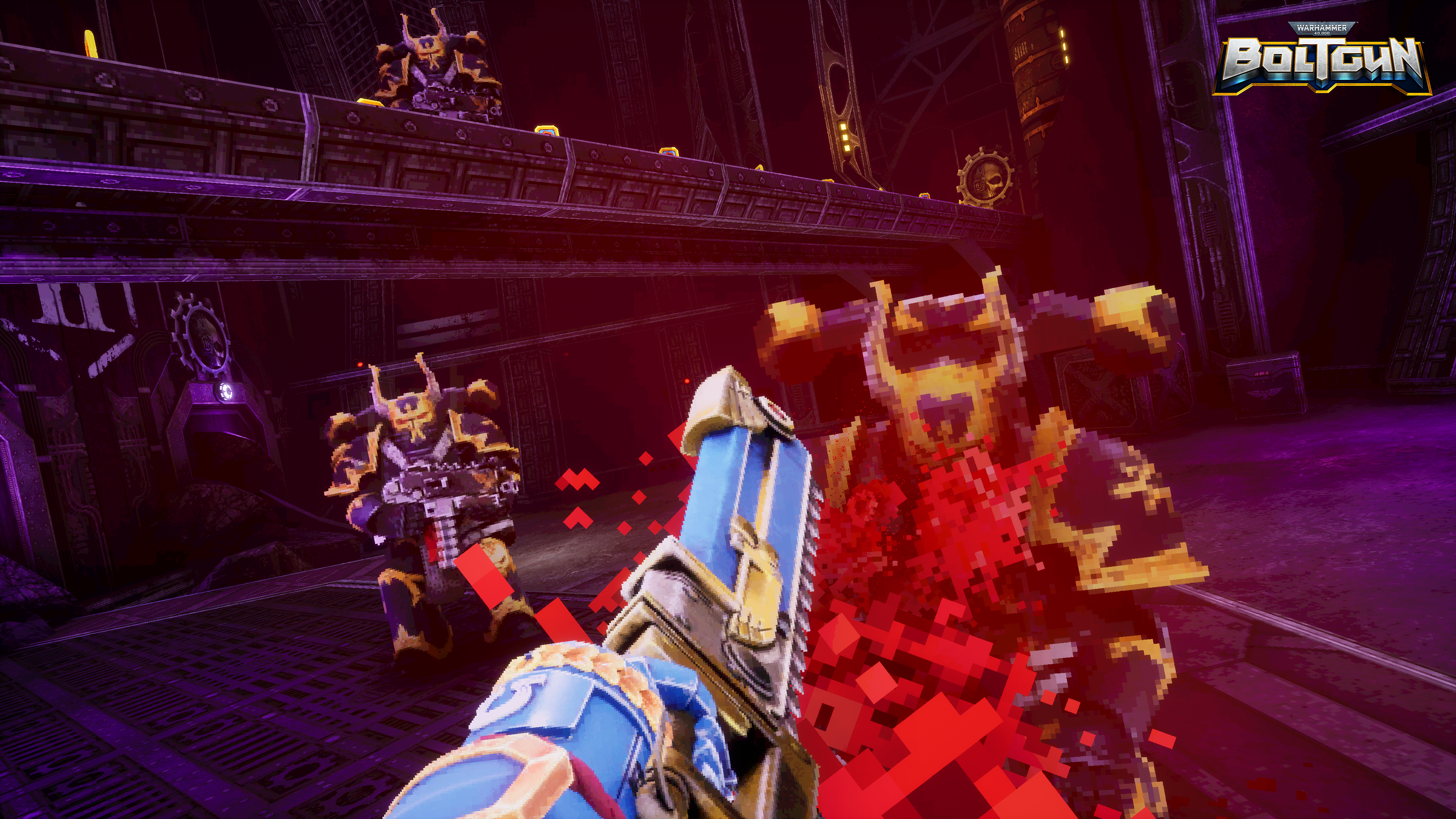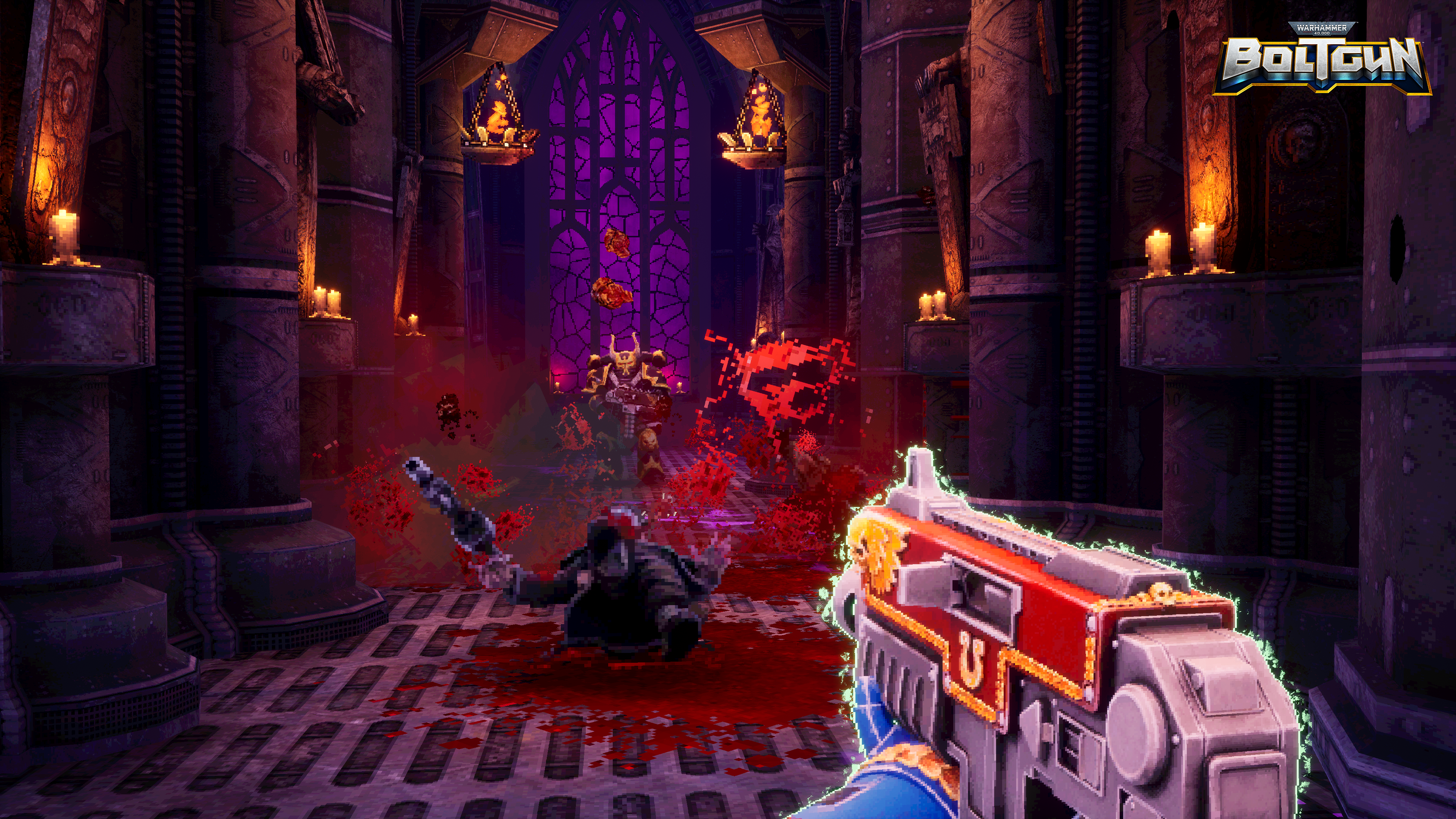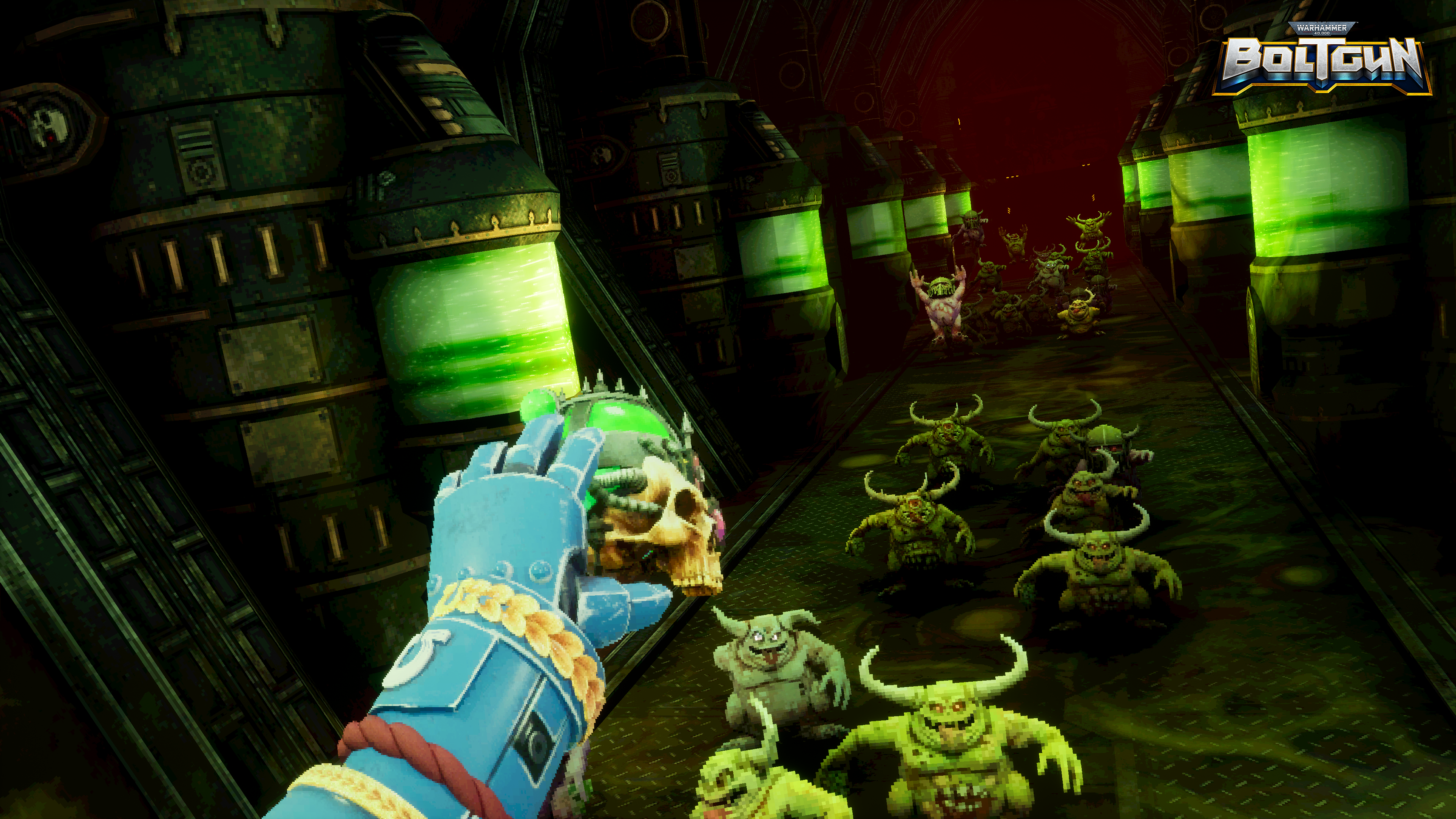TechRadar Verdict
A sterling example of the newly-resurrected 'boomer shooter' genre, Warhammer 40,000: Boltgun offers extremely tight shooting, excellent sound and world design, and one of the best guns I've ever fired in a video game. Yes, it's the boltgun.
Pros
- +
Fast-paced and highly enjoyable gunplay
- +
Great level design
- +
Music and sound effects are excellent
- +
Good difficulty curve
Cons
- -
Charge dash ability feels wonky
- -
Weapon damage system isn't well-explained
- -
Other weapons just aren't as fun as the titular boltgun
Why you can trust TechRadar
Time played: 12 hours
Platform reviewed: PC
Available on: Nintendo Switch, PlayStation 5, PlayStation 4, Xbox One, Xbox Series X|S, PC
Back when I first loaded up Warhammer 40,000: Space Marine for the Xbox 360, life was good. It was the heady days of 2011, and I was a teenager - a typically broke teenager, obsessed with the dense canon of the Warhammer universe but lacking the funds to purchase all those tiny, ludicrously expensive figurines and the paints with which to adorn them. A used copy of Space Marine, though? That I could afford, and I bloody loved it.
At the time, I thought it was what I'd been looking for: a crunching, brutal simulation of life as one of the God-Emperor's titular supersoldiers. I cleaved my way through swaths of Orks, chainsword buzzing and boltgun cracking. I was a force of nature, a thousand-kilo unstoppable fridge on legs. The ground shook as I marched, slow but inorexable, towards increasingly gory victories. And at the time, I was wrong.
Warhammer 40,000: Boltgun is what I was really looking for. Did you know that Space Marines can fight for five days straight without rest, jump four meters straight up into the air, and run as fast as 90 kilometers per hour? I did, and apparently Auroch Digital (the developers of Boltgun) did too; here, you're not a plodding tank, you're an elephant with rockets strapped to it.
Okay, boomer
Boltgun is what we affectionately refer to as a 'boomer shooter' - a first-person shooter in the vein of 90s classics such as Doom and Quake, and a genre that has enjoyed something of a resurgence in recent years since the latter series' 2016 reboot.
The enormous popularity of Doom 2016 and its speed-metal sequel Doom Eternal spawns plenty of riffs (no pun intended) on the theme. Many of these, like the excellent Dusk and early-access gem Ultrakill, have eschewed modern graphics in favor of a return to the low-poly glory of their forebears, and it is this path that Boltgun treads.
In the style of the very first Doom, Warhammer 40,000: Boltgun utilizes both 3D and 2D art styles; blocky, three-dimensional polygons used to build the gameworld, and flat pixel-art sprites for the (extremely numerous) enemies that occupy it. It's a timeless style, and enemy models have the exact right amount of detail to make them visually distinct without compromising the retro aesthetic.

The environments are similarly excellent. Starting out in the snow-blasted outskirts of a derelict industrial fortress, Boltgun mixes things up every time I started to worry my surroundings might be getting stale: military settlements give way to demon-infested catacombs, gothic cathedrals, and cavernous forges dripping with molten metal. Each chapter of the campaign is broken into pleasingly bite-sized levels that can be completed in under an hour apiece.
Sign up for breaking news, reviews, opinion, top tech deals, and more.
Sound design wasn’t skimped on, either. The soundtrack provides exactly the sort of pulse-pounding combination of industrial metal and grand orchestral overtures that I’d expect from a Warhammer 40,000 game, and the sound effects - especially those of the guns - are fantastic. I particularly appreciate how much care was taken to differentiate the sounds of different spent bullet casings and shotgun shells hitting the floor; imperceptible in the heat of battle, but perfectly punctuating the final moments of a lengthy gunfight.
Fighting the hordes of Chaos
There’s not much going on in the way of story here, but that’s okay: Boltgun understands that nobody is really here to watch lengthy cutscenes, they’re here to blast demons. You occupy the power-armored boots of the nameless Sternguard Veteran, summoned by an Imperial Inquisitor to investigate suspicious (read: demonic) goings-on down on the surface of a Forge World.
You get an intro cinematic, lovingly rendered in old-school pixel-art stills, and you get occasional expository dialogue from your sole companion - a hovering servo-skull, which for the uninitiated is a human skull turned into a helper drone - but for the most part, the plot takes a back seat to the action, which is fine. There are actually a few interesting little narrative beats later on (which, incredibly, relate in part to the events of 2011’s Space Marine), but I won’t spoil anything here.

Anyone who has played even a single boomer shooter will probably feel right at home here. There’s a sort of beautiful simplicity to Boltgun; you have your guns, your chainsword, and your grenades, and that’s about it. There is a sort of melee charge ability with a cooldown that can apparently stun some enemies, but I found it a bit too unreliable in the heat of combat.
I turned on sprint toggle in the settings menu after playing the first chapter with my finger glued to the shift key, since many of Boltgun’s battles encourage you to keep moving as much as possible. You really are incredibly fast and agile, deepening the power fantasy as you weave between enemy projectiles to deliver a crunching chainsword finisher. Obstacles to getting into this ‘flow state’ are minimized; fall to your death and the game resets you almost instantly.
For the Emperor of Mankind
There’s no minimap (or any other kind of map) but only very rarely did I get lost. Levels are mostly linear, with some of the expected back-tracking and key-hunting here and there but nothing that takes you out of the action for too long. Quite frequently, you’ll find yourself locked in a large room with waves of enemies to clear out before you can progress, but the designs of these arenas are strong and varied enough that this never feels like a chore.
The overall level of challenge feels exceptionally well-balanced. I played on Hard and didn’t die once during the first chapter, but later levels ramped up the difficulty to a point that felt punishing but not unfair. There are a handful of mildly annoying enemies - the flying Screamers can be a pain to deal with - but for the most part, I found Boltgun to provide a sound degree of difficulty throughout.

In a rather amusing juxtaposition to the Imperium’s cold in-lore authoritarianism, there are some solid accessibility features here, including an invincibility mode that allows you to experience the whole game in true power fantasy mode. You can also adjust the ‘retro’ settings to increase pixelation or reduce draw distances, in case you’re roleplaying as a person who lives in 1995.
Naturally, as a classic shooter, Boltgun’s levels are littered with ammo and health pickups, which are frequently placed for player direction. You’ve got armor too, stylized here as holy ‘Contempt’ for the forces of evil. There are also secret items hidden around each level, some of which grant you temporary bonuses like unlimited ammo or boosted damage, which helps to encourage extra exploration.
Guns, guns, guns
Speaking of ammo, let’s talk about Boltgun’s boltgun. The first weapon you acquire, this iconic Space Marine sidearm is simultaneously the game’s biggest strength and its greatest weakness.
You see, it’s absolutely awesome. This thing feels so damn good to fire, like a blessed full-auto lovechild of Bulletstorm’s Peacemaker and Doom Eternal’s Heavy Cannon. Rank-and-file enemies explode into showers of pixelated gore with just a few shots, with stellar sound design and physical feedback.
Why is this a problem? Because it’s the first gun you get, and I didn’t feel enthused to use most of the ones that came after. Boltgun has a total of eight weapons, and only one - the highly enjoyable Vengeance Launcher - really reached the same level of enjoyment as the boltgun. I rarely felt compelled to use anything else. In fact, I actively avoided the Heavy Bolter due to its movement speed cap, which felt counterproductive to the fun I was having zooming around at speeds approaching Mach 1.

The problem this creates is that while the Sternguard Veteran’s signature firearm is great fun to use, the game employs the tabletop game’s ‘weapon strength vs enemy toughness’, whereby a weapon will deal reduced damage to an enemy with a higher toughness stat. This system isn’t explained particularly well (there’s very little handholding here) but it’s fairly intuitive provide you keep an eye on the numbers next to enemy health bars.
What this means in practice is that certain strong enemies are less affected by lower-strength guns; the 3-strength shotgun is fine for clearing out packs of lesser demons, but come up against a 5-toughness Chaos Terminator and you’re going to want something like the more powerful plasma gun. The boltgun itself is 4-strength, though - not even the lowest-strength gun in the game - which doesn’t really encourage you to switch off it unless you absolutely have to.
The annihilation of your enemies

Really, though, this feels like a bit of a minor gripe for me when the game is just this fun to play. Perhaps other players will love the Heavy Bolter’s slow but relentless stream of leaden death, or find that the charge dash mechanic is actually great for them.
There’s enough here for every shooter fan to enjoy, and the simple fact is that I had a ton of fun playing Boltgun. It delivers exactly what it promises: high-octane shooter action that draws on some of the best its setting has to offer.
Existing fans of the 40,000 universe are certain to appreciate the dedicated recreation of an Imperium Forge World and all the horrible, demonic, no-good inhabitants you’ll gun down while exploring it, but part of Boltgun’s beauty is that you don’t need to know a damn thing about the Warhammer canon to enjoy it. You’re a supersoldier in power armor and your job is to kill demons. What are you waiting for? Hop to it.
Warhammer 40,000: Boltgun was reviewed on PC with a code supplied by the publisher.

Christian is TechRadar’s UK-based Computing Editor. He came to us from Maximum PC magazine, where he fell in love with computer hardware and building PCs. He was a regular fixture amongst our freelance review team before making the jump to TechRadar, and can usually be found drooling over the latest high-end graphics card or gaming laptop before looking at his bank account balance and crying.
Christian is a keen campaigner for LGBTQ+ rights and the owner of a charming rescue dog named Lucy, having adopted her after he beat cancer in 2021. She keeps him fit and healthy through a combination of face-licking and long walks, and only occasionally barks at him to demand treats when he’s trying to work from home.
